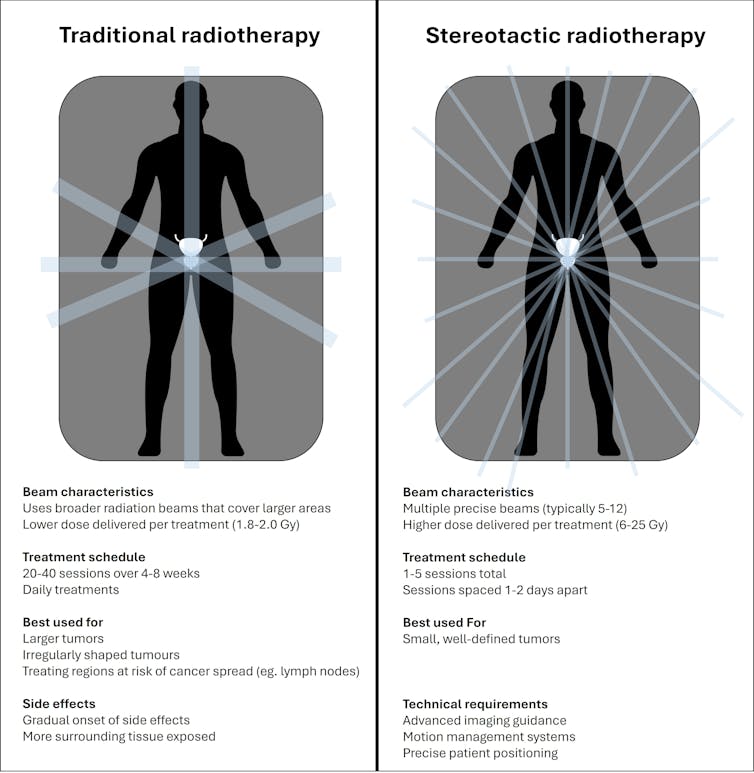
Prostate cancer is Australia’s most commonly diagnosed cancer. One in six men will be diagnosed by the time they turn 85.
Cancers are abnormal groups of cells that grow uncontrollably and start invading neighbouring sites. They can also spread to other organs in the body. This is known as metastases.
Treatment of early disease, when cancer is confined to the original site, is focused on that single area, most often with surgery or radiation therapy. Treatment of advanced disease, when it has spread, often relies on treatments that can travel all around the body such as chemotherapy or immunotherapy.
A more advanced form of radiation therapy, called stereotactic ablative radiotherapy, may be able to treat both early and advanced cancers. So how does it work? And how does it compare to existing therapies?
It delivers a higher dose to a smaller target
Stereotactic radiotherapy uses high doses of radiation to target and kill cancer cells. It uses newer machines that can deliver very focused radiation beams. Combined with advances in imaging and radiation planning software this allows clinicians to “track” and target cancers.
This results in such high precision – with a targeting accuracy less than 1mm – that cancers can be safely treated with minimal risk of damaging surrounding healthy organs.
Having a higher dose means radiotherapy can be delivered in fewer treatments (one to five sessions over one to two weeks) where it previously would have been divided into many small doses (20 to 40), delivered over weeks or even months.
Stereotactic radiotherapy has increasingly been used to treat cancer in the brain and lungs. But new data has shown it can also effectively treat prostate cancer.
What did the new study find?
A study published this month in the New England Journal of Medicine compared two groups of patients with early prostate cancer with a median age of 69.8 years. Half (433 participants) received five sessions of stereotactic radiation therapy, the other half (431 participants) received standard radiation therapy consisting of at least 20 sessions.
The researchers found no long-term difference in outcomes between the groups, with 95% of patients showing no evidence of disease five years after treatment. These cure rates are equivalent to patients who had their prostates surgically removed.
Early evidence suggests that stereotactic radiation therapy appears to be as effective, less onerous and less invasive than currently available treatment options.

Prostate cancer that has spread beyond its original site is, unfortunately, incurable in most circumstances. Treatments for this stage of disease are aimed at suppressing or controlling the cancer for as long as possible.
However, studies have shown stereotactic radiation therapy can be used to target disease that has spread to distant sites in patients who have advanced prostate cancer. Researchers found stereotactic radiation therapy could render patients free of clinically evident disease for eight to 13 months, delaying the need for hormone therapy or chemotherapy.
How do the side effects compare to other cancer treatments?
Stereotactic radiation therapy is delivered daily, with painless radiation beams. In the weeks following delivery it is common to notice soreness and/or inflammation at the treated site. This reaches a level requiring medication in one-third of cases.
Erectile function is frequently impacted during prostate cancer treatment, as the nerves and blood vessels responsible for erections are often damaged.
Another recent study comparing stereotactic radiation therapy to surgery found 48% of patients treated with stereotactic radiation therapy had difficulties with their sexual function two years after treatment compared to 75% of patients who had surgery.

What are the costs? And who can access it?
Newer and more advanced radiation treatment machines can deliver more precise treatments, but these are much more expensive than standard machines. They also have more complex maintenance and operational requirements.
However, traditional radiotherapy machines can also be upgraded to provide stereotactic precision.
While the initial investment costs can be high, cost-benefit analyses show stereotactic radiation therapy for lung cancer costs the health system less than other cancer treatments and conventional radiotherapy. This is in part because treatment is completed far more quickly. Formal cost-benefit analyses have not been completed for prostate cancer but are likely to be similar.
Stereotactic radiation therapy is now widely available at most major Australian public hospitals for many cancer types, including selected lung cancers, kidney cancers, advanced brain cancers and bone cancers. This has no out-of-pocket costs for patients. It is also provided in many private centres.
However, even when a centre can deliver stereotactic radiation therapy, there is still significant variation in the devices used to deliver the therapy.
In addition, the actual planning and delivery of radiation therapy is a complex skill. Studies have shown that patients treated by clinicians with higher caseloads have better outcomes, due to their greater familiarity with these specialised techniques.
Radiotherapy departments throughout the world have rapidly upgraded their capability over the past few years to provide stereotactic radiotherapy. After the recent clinical trial findings, it’s likely prostate cancer will be added to the list of cancers treated this way.
David Kok has a clinical appointment at Peter MacCallum Cancer Centre which provides prostate cancer treatments including stereotactic radiotherapy, conventional radiotherapy and surgery.
Sathana Dushyanthen does not work for, consult, own shares in or receive funding from any company or organisation that would benefit from this article, and has disclosed no relevant affiliations beyond their academic appointment.
This article was originally published on The Conversation. Read the original article.







